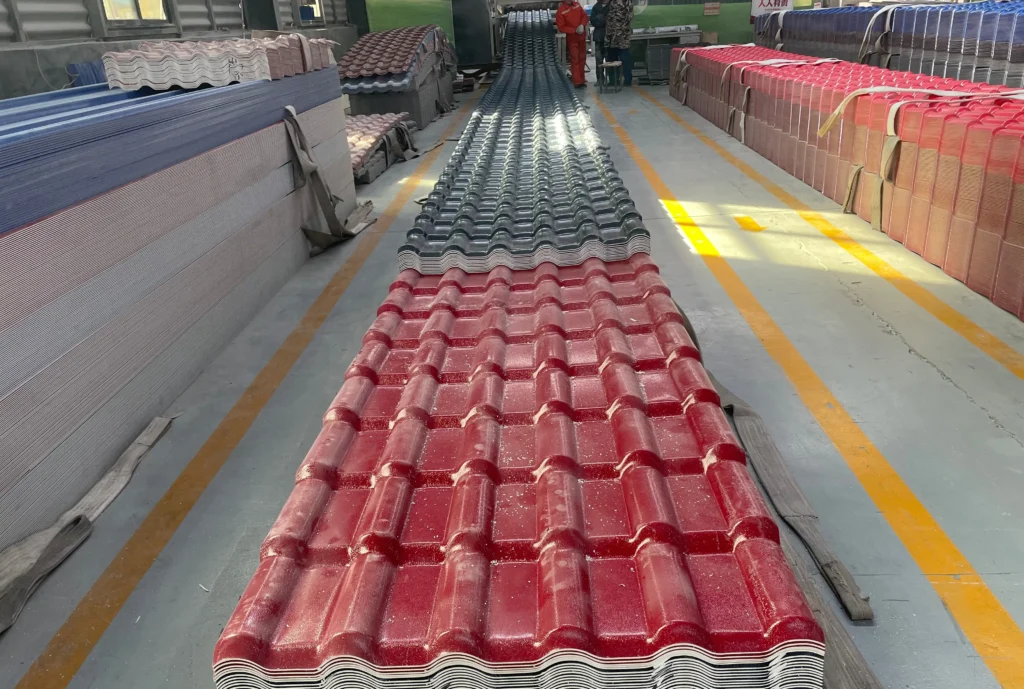
Imagine how those sturdy and colorful PVC roof panels transform from a pile of seemingly ordinary raw materials into protectors of building roofs. Let’s step into the manufacturing world of PVC roof panels and explore the details.
Raw Materials: The Cornerstone of Roof Panels
The manufacturing of PVC roof panels begins with carefully selected raw materials. Vinyl chloride monomer, abbreviated as VCM, is formed by the reaction of chlorine and ethylene. It serves as the foundation of PVC, just like the first brick in constructing a skyscraper. PVC resin is polymerized from vinyl chloride monomers. Numerous vinyl chloride molecules link together to form polymer chains, constructing the basic framework of the roof panels.
To make PVC resin more malleable, plasticizers are indispensable. They are like magical potions. Once added, they enhance the flexibility and processability of the resin, facilitating subsequent shaping. In the past, phthalate plasticizers were the mainstream, but nowadays, with the increasing emphasis on environmental protection, bio-based plasticizers are gradually gaining popularity. Stabilizers act as loyal guardians. In the high-temperature environment of manufacturing, they protect PVC from degradation, providing thermal stability to the panels and preventing oxidation. Additionally, the addition of fillers and pigments can not only enhance specific properties of the panels but also endow them with various colors to meet the requirements of different architectural styles.
Manufacturing Process: A Precise Craftsmanship Journey
Polymerization: The Dream Sets Sail
Polymerization is the first step in manufacturing PVC roof panels, just like a seed sprouting, initiating the birth journey of the roof panels. In this stage, vinyl chloride monomers undergo the polymerization process. Manufacturers achieve this through emulsion polymerization or suspension polymerization, connecting multiple VCM molecules to form long polymer chains, laying the foundation for subsequent production.
Production of PVC Resin: The Embryo Emerges
After polymerization, PVC resin appears in the form of small particles, commonly known as PVC resin particles. These tiny particles carry the potential to become high-quality roof panels and are important substrates for subsequent processing.
Compounding: Injecting the Soul
Next, manufacturers embark on a “magical blending” process. They mix PVC resin with additives such as pigments, stabilizers, fillers, and plasticizers in precise proportions. This process is like a chef cooking, where the quantity of each ingredient is strictly regulated. Only with accurate matching can a mixture with excellent performance be prepared.
Extrusion: Shaping the Form
The prepared PVC compound is fed into an extruder, which is like a “high-temperature furnace” that heats and melts the mixture, turning it into a uniform fluid. Subsequently, the molten PVC is extruded through a die. Depending on the type of roof panel, flat die extrusion or calendering is used to give it a specific shape and thickness, and the initial shape of a PVC roof panel starts to emerge.
Cooling and Shaping the Panels: Polishing and Molding
The newly extruded roof panels are still “soft” and need to be cooled and cured to take shape. The cooling process is crucial, just like quenching red-hot steel. Only with proper cooling can the panels be prevented from warping and deforming. After cooling, manufacturers trim the panels and cut them into the required sizes.
Embossing: Adding Charm
Many PVC roof panels have unique textures or patterns on their surfaces, which benefit from the embossing process. During the cooling process of the panels, the embossing roller acts like a seal, imprinting exquisite patterns on the surface of the panels, making the originally ordinary panels instantly distinctive, both beautiful and practical.
Surface Treatment: The Icing on the Cake
Surface treatment is an optional but crucial process that can significantly enhance performance. Corona treatment can improve the printability of the panels, making subsequent pattern printing clearer and more durable. The application of special coatings can enhance the chemical resistance of the panels, making them more durable in complex environments.
Quality Control: Strict Inspection
Quality control runs through the entire production process. Manufacturers adopt strict standards and conduct multiple tests on the panels, including tensile strength, tear resistance, and thickness measurement. Only when each indicator meets the requirements can the panels successfully “pass the inspection” and enter the next stage.
Packaging: Ready for Departure
PVC roof panels that have passed the quality inspection are finally carefully packaged. Packaging is like putting on a “protective armor” for the panels, protecting them from damage during transportation and storage, ensuring that every panel delivered to users is intact.
From the meticulous selection of raw materials to the rigorous processes in manufacturing, the birth of each PVC roof panel embodies countless wisdom and efforts. It is precisely these precise manufacturing processes that create PVC roof panels with excellent performance, beauty, and practicality, safeguarding buildings from wind and rain.



